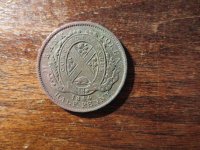- May 20, 2004
- 1,721
- 151
- Detector(s) used
- Minelab Excal 1000
- Primary Interest:
- All Treasure Hunting
Whydah's littlest pirate found
Small bone, shoe all that remain of 9-year-old who joined Black Sam Bellamy
BY THOMAS H. MAUGH II
ORIGINALLY PUBLISHED JUNE 1, 2006
Underwater archaeologists have identified the partial remains of the youngest known pirate to ply U.S. waters, a 9-year-old boy who eagerly joined Capt. Black Sam Bellamy's crew on the infamous Whydah.
Teen-age pirates were common during the early 18th century, but "this is the youngest one I have ever come across," historian Ken Kinkor of the Expedition Whydah Sea-Lab & Learning Center in Provincetown, Mass., said yesterday in announcing the discovery.
The young pirate's idyll aboard the Whydah did not last long. The ship foundered in a storm off Cape Cod three months later, sinking with all but eight of its 180-man crew. Six of the eight survivors were tried and hanged in Boston. Two defended by Cotton Mather were acquitted.
The tale of the young pirate, identified as John King, was pretty much lost to history until explorer Barry Clifford used court documents and an early salvage map to locate the Whydah in 1984 - the first time that an authenticated wreck of a pirate ship had been found.
Since then, Clifford and his divers have recovered more than 100,000 artifacts from the wreck, bringing them to the surface, conserving them, and putting them on display at their museum at the end of a Provincetown pier.
The wreck "was like a 300-year- old Wal-Mart on the bottom of the ocean," Clifford said, with a broad variety of items stolen from other ships. Despite the quantity of materials recovered, he added, "we've never really discovered the mother lode of the ship."
They did find a small shoe, a silk stocking and a short leg bone. The items had been in storage for nearly 20 years before Clifford and Kinkor recently made the connection to John King.
King's story is found in a deposition filed with the governor of Antigua on Nov. 30, 1716, by Abijah Savage, commander of the Antiguan sloop Bonetta. As was the usual practice, Savage reported to the governor the details of a pirate attack on his ship.
On Nov. 9, the Bonetta was attacked by Bellamy's ship and held for 15 days. The pirates took all of their valuables, including "a Negro Man and an Indian Boy belonging to Mr. Benjamin Wicker" before releasing them.
Savage wrote that one John King, who was sailing with his mother as a passenger from Jamaica to Antigua, "deserted his sloop, and went with the Pirates and was so far from being forced or compelled thereto by them as the deponent could perceive or learn that he declared he would Kill himself if he was Restrained, and even threatned his Mother who was then on Board as a Passenger with the Deponent."
Such depositions are usually brief and record only the most striking things that happened, Kinkor said. "It was pretty unusual for Captain Savage to have recorded it."
Kinkor noted a variety of reasons that a pirate's life might have appealed to a youngster - "a free and easy lifestyle, and a classless, democratic subculture."
Spurred by Savage's account, Clifford showed the short fibula to expedition archaeologist John de Bry and Smithsonian Institution expert David Hunt. They said the bone belonged to a child between the ages of 8 and 11.
The stocking is of woven French silk, Kinkor said, and the shoe - 2 inches in width at its widest point - is of upper-class design and craftsmanship, consistent with it having belonged to King.
The shoe and fibula were found next to a large concretion of artifacts that is now on display at the museum. Such solidified masses occur when iron objects electrolyze in sea water, catalyzing the formation of stone-like materials that bind artifacts together.
X-rays show that the mass contains many other bones, a possible skull and hundreds of other artifacts. "It's a 300-year-old time capsule," Clifford said.
Eventually, they might drill into the mass to determine whether the bones are King's.
But they are unlikely to take it apart, Clifford said. "It's much more interesting seeing the X-ray and the bones protruding."
Thomas H. Maugh II writes for the Los Angeles Times.
Small bone, shoe all that remain of 9-year-old who joined Black Sam Bellamy
BY THOMAS H. MAUGH II
ORIGINALLY PUBLISHED JUNE 1, 2006
Underwater archaeologists have identified the partial remains of the youngest known pirate to ply U.S. waters, a 9-year-old boy who eagerly joined Capt. Black Sam Bellamy's crew on the infamous Whydah.
Teen-age pirates were common during the early 18th century, but "this is the youngest one I have ever come across," historian Ken Kinkor of the Expedition Whydah Sea-Lab & Learning Center in Provincetown, Mass., said yesterday in announcing the discovery.
The young pirate's idyll aboard the Whydah did not last long. The ship foundered in a storm off Cape Cod three months later, sinking with all but eight of its 180-man crew. Six of the eight survivors were tried and hanged in Boston. Two defended by Cotton Mather were acquitted.
The tale of the young pirate, identified as John King, was pretty much lost to history until explorer Barry Clifford used court documents and an early salvage map to locate the Whydah in 1984 - the first time that an authenticated wreck of a pirate ship had been found.
Since then, Clifford and his divers have recovered more than 100,000 artifacts from the wreck, bringing them to the surface, conserving them, and putting them on display at their museum at the end of a Provincetown pier.
The wreck "was like a 300-year- old Wal-Mart on the bottom of the ocean," Clifford said, with a broad variety of items stolen from other ships. Despite the quantity of materials recovered, he added, "we've never really discovered the mother lode of the ship."
They did find a small shoe, a silk stocking and a short leg bone. The items had been in storage for nearly 20 years before Clifford and Kinkor recently made the connection to John King.
King's story is found in a deposition filed with the governor of Antigua on Nov. 30, 1716, by Abijah Savage, commander of the Antiguan sloop Bonetta. As was the usual practice, Savage reported to the governor the details of a pirate attack on his ship.
On Nov. 9, the Bonetta was attacked by Bellamy's ship and held for 15 days. The pirates took all of their valuables, including "a Negro Man and an Indian Boy belonging to Mr. Benjamin Wicker" before releasing them.
Savage wrote that one John King, who was sailing with his mother as a passenger from Jamaica to Antigua, "deserted his sloop, and went with the Pirates and was so far from being forced or compelled thereto by them as the deponent could perceive or learn that he declared he would Kill himself if he was Restrained, and even threatned his Mother who was then on Board as a Passenger with the Deponent."
Such depositions are usually brief and record only the most striking things that happened, Kinkor said. "It was pretty unusual for Captain Savage to have recorded it."
Kinkor noted a variety of reasons that a pirate's life might have appealed to a youngster - "a free and easy lifestyle, and a classless, democratic subculture."
Spurred by Savage's account, Clifford showed the short fibula to expedition archaeologist John de Bry and Smithsonian Institution expert David Hunt. They said the bone belonged to a child between the ages of 8 and 11.
The stocking is of woven French silk, Kinkor said, and the shoe - 2 inches in width at its widest point - is of upper-class design and craftsmanship, consistent with it having belonged to King.
The shoe and fibula were found next to a large concretion of artifacts that is now on display at the museum. Such solidified masses occur when iron objects electrolyze in sea water, catalyzing the formation of stone-like materials that bind artifacts together.
X-rays show that the mass contains many other bones, a possible skull and hundreds of other artifacts. "It's a 300-year-old time capsule," Clifford said.
Eventually, they might drill into the mass to determine whether the bones are King's.
But they are unlikely to take it apart, Clifford said. "It's much more interesting seeing the X-ray and the bones protruding."
Thomas H. Maugh II writes for the Los Angeles Times.



 that's amazing.
that's amazing.





